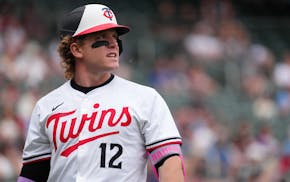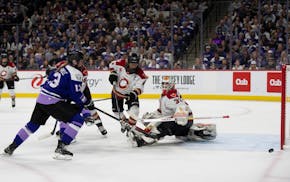MINNESOTA UNITED | ANALYSIS
Minnesota United might have played nearly eight full seasons in MLS, but when it comes to youth development, the Loons are still figuring things out.
Eight years ago, they started their academy with 13- and 14-year-olds, with the idea of having the academy grow along with the team. The pandemic's onset and other factors caused a rethink, one that eventually resulted in the club shutting down the program entirely before restarting it.
That reset, though, gave off a perception that the club didn't care much about the academy, or about the players who were left without a club. It's a criticism that's been tough for the Loons to shake. Even now, four years later, online rankings of MLS academies regularly put the Loons in last place among their MLS brethren.
The team's academy is now part of MLS' youth development league, called MLS NEXT, which included a total of 143 clubs from around the country last year — including all of the academies of MLS teams. The Loons have U-15, U-16 and U-18 teams this season.
Some of Minnesota's struggles are from their own missteps, but some of them boil down to a simple fact: developing MLS-ready players in the Upper Midwest isn't an easy thing to do.
Minnesota and Wisconsin have developed plenty of pro soccer players, but nothing like the talent that's regularly churned out of the traditional American soccer hotbeds — East Coast metro areas, Southern California, Texas and so on.
Developing high-level players creates a virtuous cycle, too, as the players of today become the local youth coaches of tomorrow. And Minnesota also pays a penalty for its weather, since playing soccer here between about November and March means forking over big bucks for an hour of time in one of the handful of local indoor fields.
'I believe in Minnesota players'
Imagine if hockey worked like soccer, in terms of player development. Now imagine running the Arizona Coyotes academy, trying to compete with Minnesota and Toronto, among other places that have advantages like "history" and "easy access to facilities" and "dozens of local coaches that played in the NHL" and "ice that forms naturally for months out of the year."
That's what it's like to be Amos Magee, Minnesota's head of development and player pathway. Give him one county in southern California, and he might have more raw material to work with than what he has in Minnesota and Wisconsin, never mind the luxury of going outside without a parka in February.
So you'd probably expect a lot of rueful sighs and shrugs from him, when he talks about the challenges of running MNUFC's academy program. Instead, the St. Paul native's eyes light up. "This is where I want to be," Magee says. "I believe in Minnesota players. I believe in the mentality here. I really like the people involved in the community here. I'm the kid who was formed in the soccer community, so I want to help the next ones move along."
There might be no better person to try to continually push this particular rock up this particular hill, in terms of local soccer bona fides. Magee played for the St. Paul Blackhawks youth club, played for St. Paul Academy, played more than a decade for the Minnesota Thunder, then went on to manage the team — and only quit as manager because he thought the team needed someone else, in order to save the club from shutting down.
This is, in short, not a man who's going to be deterred by his teams having to play bubble-dome soccer for five months out of every season.
"We need players entering our academy at an even higher level," said Magee, ticking off his to-do list. "We need better to do a better job of scouring nontraditional soccer markets in the Twin Cities and beyond.
"We need better relationships with clubs in our homegrown territory, which extends all the way to Milwaukee, and ones that are neutral territory in Iowa, South Dakota and North Dakota. There are a lot of really good soccer players out there."
Magee's overall goal is bigger than just finding more players, though; he wants to build a Midwest soccer community that can compete with the current powerhouse markets around the country.
"We're professionalizing what we do at the academy," he said. "We're going to try to push the rest of the youth clubs, and we expect those youth clubs to be pushing us, to try to move this whole boat forward."
New emphasis from above
The first academy players are now starting to come through to the first team. Fullback Devin Padelford, from Maplewood, has to be considered the academy's prize graduate; he's played 97% of the minutes, and scored 100% of the goals, of all the designated homegrown players to come through the Loons academy.
"If I can be motivation for kids, then that's awesome," Padelford said. "That's what I wanted to do this for. I want to be here for that little Minnesota kid that's in the stands like, 'Hey, I could do this, this is my boyhood club.' Because that's how it is, all over the world."
The biggest difference for the Loons in 2024, under new chief soccer officer Khaled El-Ahmad and new manager Eric Ramsay, is the overall attitude toward the academy.
"We have a chief soccer officer and the head coach that prioritize the value of young players in your club," Magee said. "It isn't me trying to knock on their door and convince them, it's them knocking on my door to say, 'How can we help?' That's the fundamental cultural change."
As an example, he cites another young player that just signed a deal with the Loons — winger Darius Randell. "Even if Eric isn't saying Randell is ready yet to play with the first team, he is constantly asking to see Darius. He's constantly talking to me about where he is in his development. How can he help?"
The "pathway," as everyone at the club invariably refers to it, is starting to bear other green shoots, too. Winger Loïc Mesanvi came to the club's academy after playing high school soccer in Lakeville and playing for lower-league stalwarts Minneapolis City SC; he progressed through to the second team, and just signed a contract with the first team so that he'd be eligible for more first-team playing time this season.
MNUFC will know it's starting to hit its goals when its young players are even more prepared — ready to contribute to the first team, not only fill roles for the second team. But already, the Loons are moving players along. Twelve different academy players have played at least five times for MNUFC2 this season, counting Randell before his new contract.
Maybe Mesanvi has the correct overall attitude. "I think with what the new upstairs people are trying to do this year," he said, "giving a lot of younger guys time with the second team, me playing with the first team — just give us a little bit and we'll see."

Twins pitcher Ober struggling to regain fastball velocity

Twins lose second in a row to Blue Jays as bullpen falters late
What is the 'House settlement,' and what does it mean for the Gophers and NCAA?

